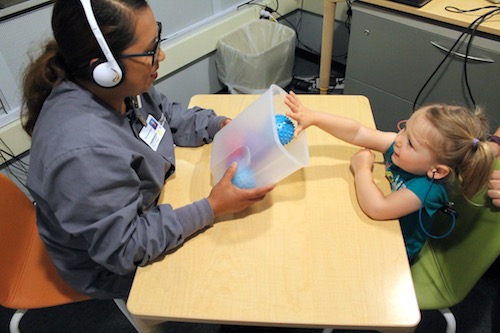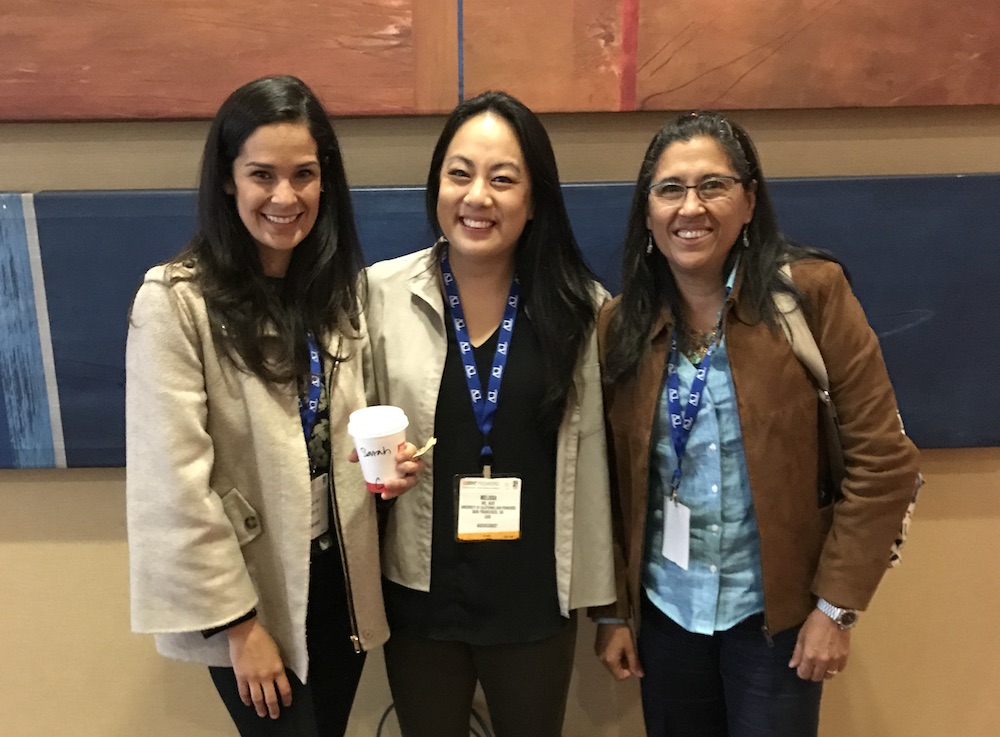Types of Hearing Tests
Newborn Hearing Screening
No child is too young for a hearing test. A newborn hearing screening is required for every child born in the state of California. If a baby is born at a hospital, the screening typically occurs prior to a baby being discharged home. If a baby is born at home or at a birthing center without equipment or personnel for a hearing screening, he or she can be seen in an outpatient clinic to perform the screening.
The California Newborn Hearing Screening program was created to detect hearing loss as early as possible because children have a critical language learning period which begins at birth.If an infant has hearing loss, he or she may not be receiving adequate access to sounds to promote speech and language development.
The newborn hearing screening test involves us measuring responses from the ear’s sensory cells as well as the auditory nerves. We are best able to measure these while the baby is asleep as external sounds and movement can interfere with the measurements. Be sure to review our "Natural Sleep ABR" instructions to prepare your baby for his or her visit.
If a child does not pass a newborn hearing screening, a more thorough diagnostic test should be performed to determine his or her hearing status.
Auditory Brainstem Response (ABR)
Auditory Brainstem Response (ABR) testing gives information about the inner ear (cochlea), auditory nerve, and auditory brainstem. An ABR is most often conducted on infants who have failed a newborn hearing screen, however it can also be used with children who have a difficult time with conventional behavioral methods of hearing tests, or are unable to reliably complete behavioral audiometry. ABR is also indicated for a person with signs, symptoms, or complaints suggesting a type of hearing loss in the brain or a brain pathway (e.g., auditory neuropathy).
A diagnostic ABR is performed by placing electrodes on the forehead and ears.From brain wave activity, we can determine auditory nerve integrity and estimate hearing thresholds. If a child is under 6 months of age, the ABR can be conducted while the baby sleeps, however children 6 months and older need to be sedated to perform the test accurately.
Otoacoustic Emissions (OAEs)
OAEs are sounds generated by the inner ear sensory cells (outer hair cells) when stimulated by a sound. When sound stimulates the cochlea, the outer hair cells activate and produce a nearly inaudible sound that can be measured with a sensitive microphone in the ear canal.Individuals with normal hearing almost always produce OAEs. Those with worse than mild to moderate hearing loss do not produce OAEs. The OAE test may be used as part of a newborn hearing screening program, and/or as an objective cross–check measure during a comprehensive hearing test battery. OAE measurements are affected by blockage in the outer ear canal (such as earwax) or middle ear (such as fluid build-up).Therefore results are best obtained when the ears are clear.
Conditioned Play Audiometry (CPA)
 Conditioned Play Audiometry is commonly used with toddlers and preschoolers (ages 2–6). The child is trained to perform an activity each time a sound is heard (e.g., putting a block in a box, placing pegs in a hole, etc.).
Conditioned Play Audiometry is commonly used with toddlers and preschoolers (ages 2–6). The child is trained to perform an activity each time a sound is heard (e.g., putting a block in a box, placing pegs in a hole, etc.).
Visual Reinforcement Audiometry (VRA)
Visual Reinforcement Audiometry is the method most often used for testing children between 7 months and 2–3 years of age. The child’s natural tendency to turn toward a sound is used to train them to look toward a controlled sound source. When the child gives a correct response (e.g., looking to a source of sound when it is presented), the child is "rewarded" through a visual reinforcement (e.g., toys, lights, or screens are activated).
Behavioral Observation Audiometry (BOA)
Behavioral Observation Audiometry is used with infants and other children who are developmentally unable to perform VRA or CPA. This testing looks for consistent responses (e.g., eyes/head going up, ceasing to suck on pacifier or ceasing movement) each time a stimulus sound is presented in the test booth.
Amplification
Hearing Aid Technology
A hearing aid receives sound through a microphone, which converts the sound waves into electrical signals and sends them to an amplifier. The amplifier increases the power of the signals and sends them to the ear through a receiver (speaker). Though today’s hearing aids have these three basic parts, they are supported by sophisticated sound processing features, making them into tiny but powerful computers!
A hearing aid is programmed specifically for an individual’s hearing loss. There is no one-size-fits-all hearing aid. It takes careful adjustment by an audiologist to ensure a correct fit. We work with hearing devices from the top hearing aid manufacturers. The types of hearing devices we dispense through our clinic are listed below:

Multidisciplinary Hearing Loss Clinic
Our pediatric audiologists are members of UCSF’s multidisciplinary Hearing Loss Clinic team. Hearing Loss Clinic provides comprehensive assessment of your child's hearing impairment, develops a unified plan to optimize your child's hearing health, and helps coordinate this plan in your community. For more information, please click here.
UCSF Pediatric Audiology Clinic at Mission Bay
To contact our clinic online, please click here.
Phone: (415) 353-2101
Ron Conway Family Gateway Medical Building
1825 Fourth St., Fifth Floor, 5C
San Francisco, CA 94158
Hours
Monday, Tuesday, Wednesday and Friday
8:30 a.m. – 5 p.m.
Thursday
10 a.m. – 5 p.m.
